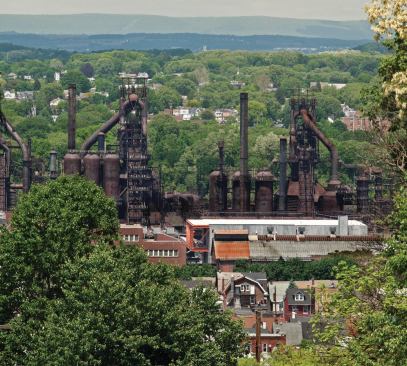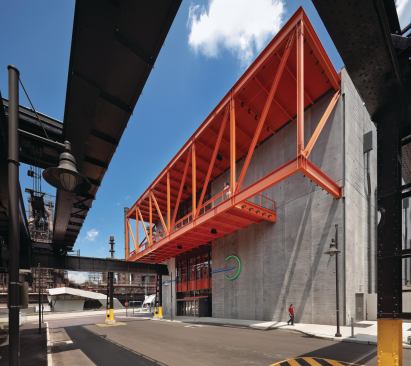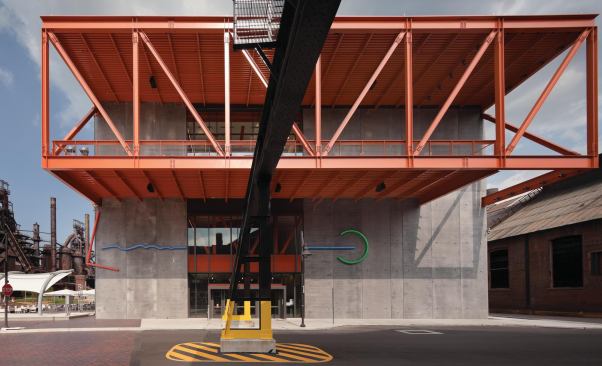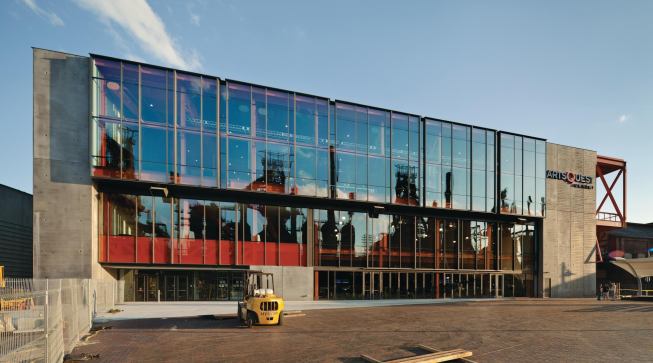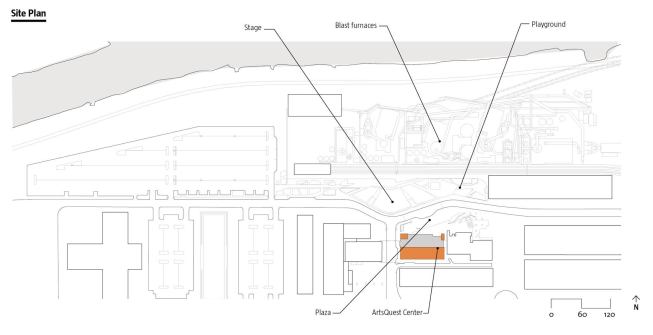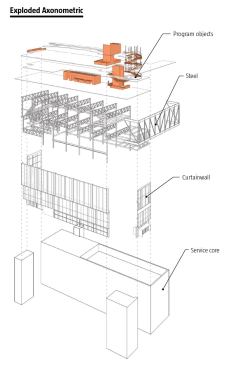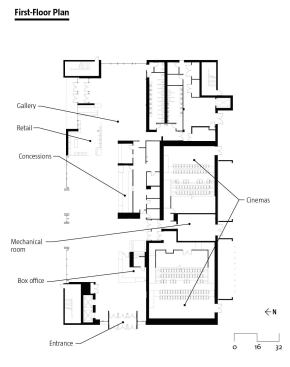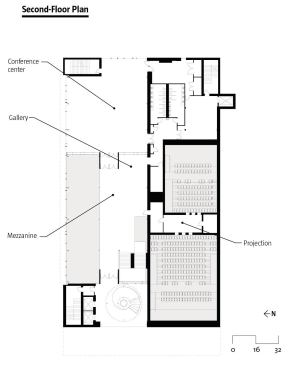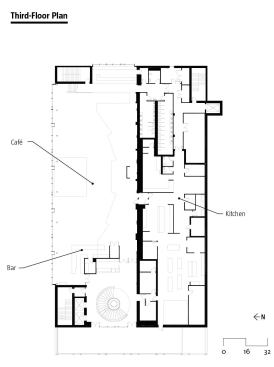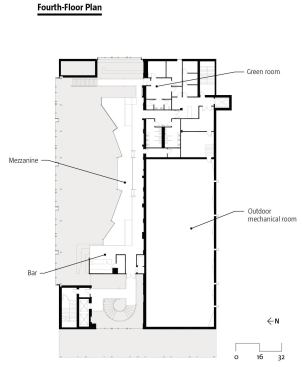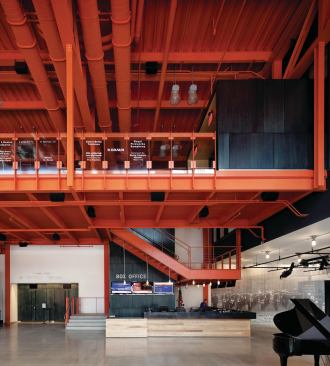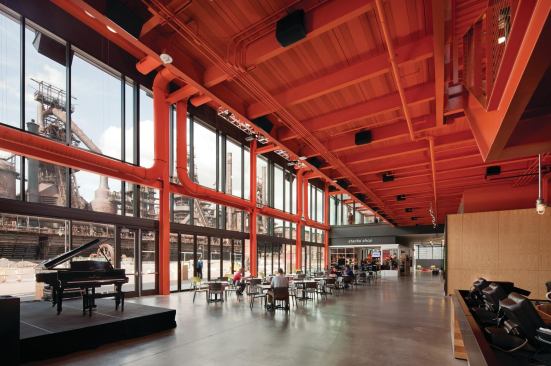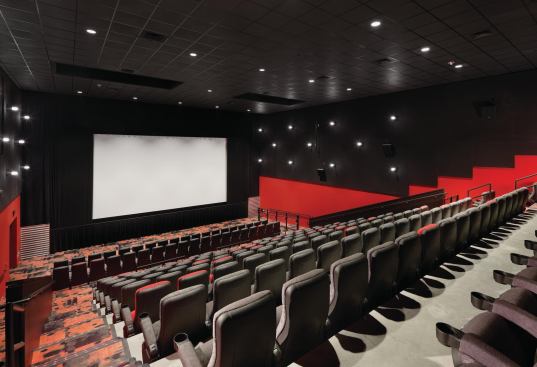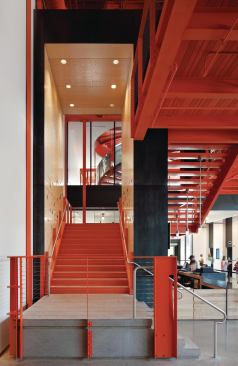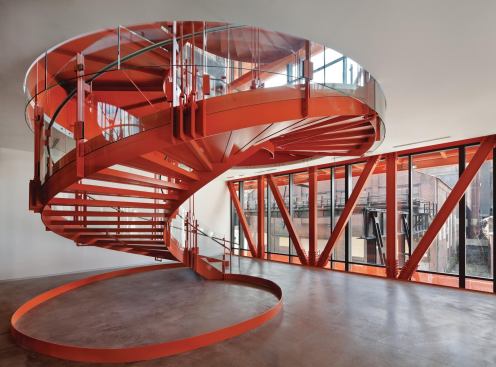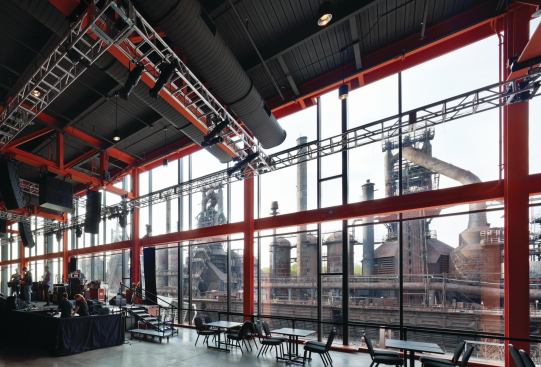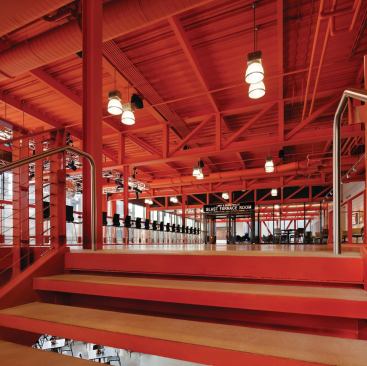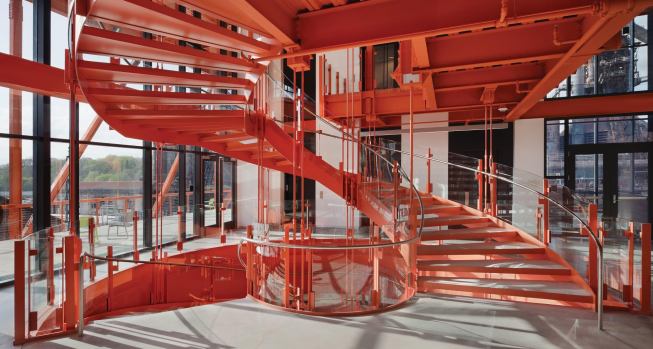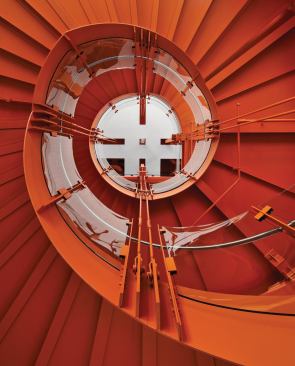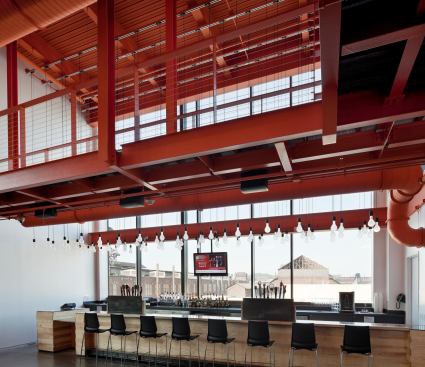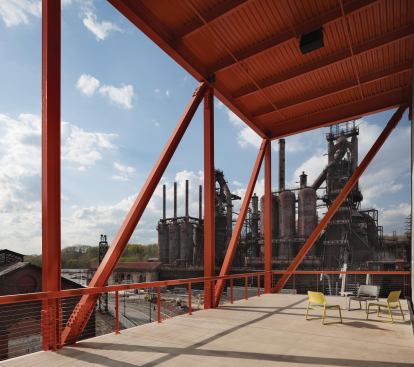Paul Warchol
The ArtsQuest Center at SteelStacks stands in front of the remai…
Joseph Biondo, AIA, principal at Spillman Farmer Architects, was born and raised in the firm’s hometown of Bethlehem, Pa. The one-time hotbed of U.S. manufacturing was an industrial dynamo in Biondo’s youth, and he remembers well the masses of black smoke that issued from the mighty blast furnaces at the heart of the Bethlehem Steel Corp.’s vast compound on the Lehigh River. “When I was a kid,” Biondo says, “I thought those smokestacks made the clouds.”
Nowadays, Bethlehem is out of the cloud-making business: the plant ceased operations in 1995. But the impressive hulks of the old steelworks remain, monuments to an America that Walter Gropius called the “Mutterland der Industrie.”
For Bethlehem, it is a patrimony that has come with its share of family feuds, as private and public interests have wrangled over the future of the steelworks site. Finally, after years of municipal foot-dragging, the city found a new role for its famous industrial facility: at its eastern end, a new resort casino and retail development, and to the west (largely underwritten by the gaming business) a new arts-and-entertainment campus to be called SteelStacks. Standing in the shadow of the derelict mills, the centerpiece of the new cultural complex is the just-completed ArtsQuest Center, a $17.4 million performance venue designed by Spillman as a paean to Bethlehem’s past, and the firm’s. The four-story, 67,000-square-foot facility is a simple rectangular volume, simply expressed in a hybrid steel-and-concrete frame. Yet within that outline, along with a program of bars, cafés, movie theaters, and stages, the architects have packed a subtle historical polemic.
Toolbox: Site work
Spillman Farmer’s William Deegan is one member of the design team whose father worked (as they say in Bethlehem) “in the steel.” “I remember dropping him off in the company parking lot. … You could feel the heat from hundreds of yards away.”
Now that much of the Bethlehem Steel compound—all 163 acres of it—looks like one enormous parking lot, it’s hard to get a sense of the real scale of the works at their height. Only a fraction of the sheds, cranes, and workshops remain standing, and most of those are in pretty poor repair; many furnaces still remain, though. The perils of working in and among demolished and semiruined industrial relics might have made the project tough going for Spillman Farmer; but fortunately for them, extensive remediation had already been carried out by the site’s new owners—the Sands Casino Resort, which opened in a bulky block of buildings just down the road in 2009.
The resort contracted with demolition experts Brandenburg Industries and construction managers Alvin H. Butz to remove structurally unsound buildings and chemical contaminants from a large swath of the steelwork grounds, including the No. 2 Hammer Shop that stood on the present site of ArtsQuest. “We wanted to preserve” the original structure, says Spillman Farmer associate Michael Metzger, AIA, “but we just couldn’t.” Even before that, as early as the late ’90s, federal and state environmental authorities had already conducted extensive soil removal and groundwater testing to ready the way for the factory’s future.
Which is not to say that Spillman Farmer wasn’t prepared to assume the odd risk in taking on the spectacular brownfield site. Inside ArtsQuest, surfaces clad in Pennsylvania ash abound, their alternating dark and light finishes intended to recall the charred brick interiors of the nearby furnaces. But how did the Spillman team know that, since the insides of the stacks are closed to the public? Sheepish grins all around: They found their own way in, apparently.
“The intent of the design was to go toe-to-toe with the blast furnaces,” Biondo says. The service areas are all thrust to the building’s southern side, leaving the glazed-in public spaces to confront the looming structures of the old plant to the north head-on. Seen from the window of ArtsQuest’s third-floor Musikfest Café, the network of catwalks and bellows resembles a rust-bound pipe organ, making it a striking backdrop for the performers who have taken the main stage since the space opened in April. Compositionally, too, the center gestures toward the furnaces, with its articulated, boxlike interior forms suggesting something of the towers’ bristling functional complexity. But the new building doesn’t attempt to outdo the old—if anything, it errs on the side of understatement.
To save it from value-engineered blandness, ArtsQuest has not only its sensational site, but a heightened sense of place contrived by its designers. Just inside the main entrance, a blown-up black-and-white photo, unearthed from the Bethlehem Steel archives, shows the uniformed company brass band mustering on the exact spot where ArtsQuest stands today.
And then there is the unique poignancy in the choice of Spillman Farmer as architect. The firm dates back 87 years, when two Bethlehem Steel employees set up shop as homebuilders to wealthy company executives. Today, the practice’s office sits on a converted brownfield only minutes from SteelStacks, and among the 30 designers working there are the sons and daughters of former steel men. For them, this project was a return to their roots.
As Biondo puts it, “We’re a firm in transition.” ArtsQuest stands as a specifically local reflection on a specifically local condition, but it’s also a bid to expand beyond the firm’s regional horizons. Significantly, the architects beat out heavy hitter David Rockwell for the commission, after the internationally known designer had landed the project in an earlier search. In that light, the modesty—the reticence, even—of Spillman Farmer’s approach seems a very definite statement about space-making in the postindustrial context: a little history, it says, can trump a lot of showmanship in bringing a place back to life.
Project Credits
Project ArtsQuest Center at SteelStacks, Bethlehem, Pa.
Client/Owner ArtsQuest
Architect Spillman Farmer Architects—Barry Pell, AIA (managing principal); Joseph N. Biondo, AIA (design principal); Michael Metzger, AIA (project architect); William Deegan (senior designer); Joseph Balsamo, Brian Brandis, AIA, Chris Connors, Randy Galiotto, Deborah Innis, Christa Kraftician, AIA, Sierra Krause, Deirdre Kwiatek, Clint Newton, Elliot Nolter, Mark Piell, Patrick Ruggerio, Mike Savage, Charles Shoemaker, AIA, Wayne Stitt, AIA, Joanne Titcomb, Salvatore Verrastro, AIA (project team)
M/E/P Engineer Brinjac Engineering
Structural Engineer Barry Isett & Associates
Acoustic Consultant Acoustic Dimensions
Landscape Architect Wallace Roberts & Todd
Civil Engineer French & Parrello Associates
Food Service Consultant Porter Khouw Consulting
Commissioning Consultant The Stone House Group
Specifications Consultant Conspectus
Construction Manager Alvin H. Butz
Owner’s Consultant (Audio/Visual) AVI-SPL
Owner’s Consultant (Cinema) Full Aperture Systems
Owner’s Consultant (Planning & Fundraising Counsel) The North Group
Owner’s Consultant (Branding & Environmental Graphics) Westlake Reed Leskosky
Owner’s Consultant (Food Service) Singer Equipment Co.
Owner’s Consultant (Sculpture) Stephen Antonakos Studio; The Glass Studio at the Banana Factory
Owner’s Consultant (Communications) Convergent Communications
Owner’s Consultant (Furniture) Corporate Environments; Corporate Facilities
Owner’s Consultant (Retail) Vori Kriaris Retail Design & Store Planning
SteelStacks Plaza Design Team Wallace Roberts & Todd; Artefact; L’Observatoire International; Klein and Hoffman; Keystone Consulting; Lehigh Valley Engineering; HDR; Metropolitan Acoustics; Simpson Gumpertz & Heger
Size 68,000 square feet
Construction Cost $17.4 million
Materials and Sources
Acoustic Curtains Besteel rosebrand.com
Acoustical System Knauf Insulation knaufusa.com; Kinetics Noise Control kineticsnoise.com; Metal-Dek (Versa-Dek S Acoustical) metaldek.com
Carpet Lees leescarpets.com
Ceilings Armstrong armstrong.com
Exterior Wall Systems Laminators (Omega-Lite exterior metal panels) laminatorsinc.com; Universal Concrete universalconcrete.com
Doors & Hardware Ingersoll-Rand (Steelcraft) steelcraft.com; Rockwood Mfg. Co. rockwoodmfg.com; Sargent Mfg. Co. sargentlock.com; Solar Innovations solarinnovations.com; Tubelite tubeliteinc.com
Fabrics and Finishes Knoll knoll.com; Glassfim Enterprises (Lumisty) lumistyfilm.com
Flooring Polished concrete; Resinous flooring; StonePeak Ceramics stonepeakceramics.com
Furniture Herman Miller hermanmiller.com; Knoll knoll.com; Driade driade com; Camatic camatic.com.au
Glass JE Berkowitz www.jeberkowitz.com
HVAC Carrier www.commercial.carrier.com; Mitsubishi Electric (split system) mehvac.com
Lighting Control Systems Lutron Electronics Co. lutron.com; Lehigh Electric Products lehighdim.com
Lighting Hi-Lite Mfg. Co. hilitemfg.com; Philips Lightolier lightolier.com; Philips Widelite widelite.com; Tivoli tivolilighting.com; Winona Lighting winonalighting.com
Masonry and Stone Sand-filled CMU
Metal Hot-rolled steel
Millwork Ash; Nevamar nevamar.com; Corian dupont.com
Paints Sherwin-Williams Co. sherwin-williams.com
Roll Down Shades Lutron Electronics Co. lutron.com
Structure Braced steel frame and precast concrete panels
Wallcoverings Knoll knoll.com; 3M Graphic Panels 3m.com
Windows and Curtainwalls Tubelite tubelite.com
